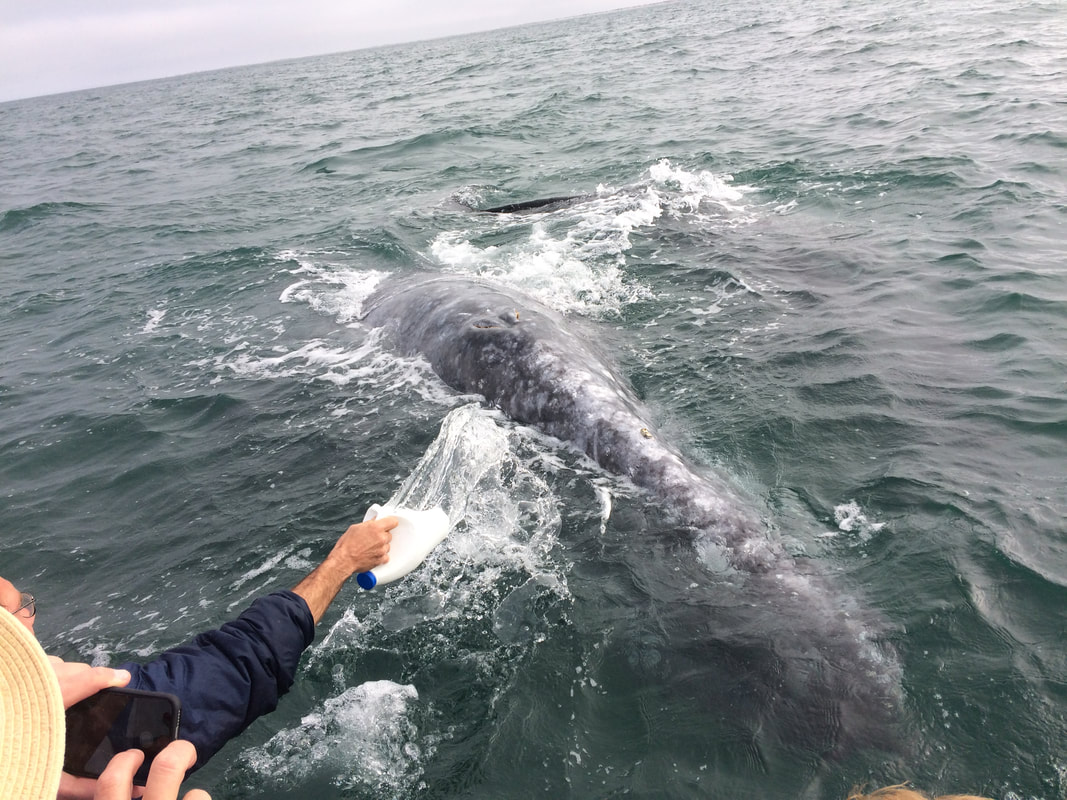Some of us who've traveled with Michael Stocker to San Ignacio Lagoon, to meet some friendly gray whales, now are creating fundraisers for his organization. A guest column by me in the 12 Oct 2017 Point Reyes Light says more:
Here on Earth, we’re learning what it means to live in truly dangerous times. Radical disruption is at work in all life zones, including the ones we’re conditioned to believe are safe and stable. Hearts are breaking for inhabitants of disaster areas both around the world and close to home.
As humans, we are naturally focused on biomes that support terrestrial life. Yet we sometimes catch a glimpse of the other 75 percent of our planet’s livable surface: the ocean. We might spy a big spout or broad flukes just off our coast, where large numbers of humpback whales are now feasting, and for a moment imagine their unseen environment.
Yet at least one person in West Marin spends many waking hours (and doubtless much of his dream time) considering whales and their kin. Michael Stocker, a Lagunitas resident, studies marine mammals and the biggest challenge they face: noise.
“Cetaceans use sound—with great finesse—to orient their travels and to communicate with one another, often across hundreds, if not thousands, of miles,” he explains. “So the noise that humans are causing in the world’s ocean poses enormous problems for these intelligent beings.”
The enormity of the problem became clear during the 1990s. Whales and dolphins began beaching themselves in many regions, sometimes in large numbers, at a time when United States and NATO naval exercises were testing sonic technology.
“It was the catastrophic strandings of cetaceans that brought public attention to the ocean noise issue,” Stocker says. “But it’s the increasing industrialization of the ocean that’s causing a much more sinister problem. A growing ‘acoustic smog’ is gradually obscuring the environmental signals that are important to all marine life.”
As a bio-acoustician who studied both physics and natural sciences, Michael Stocker is equipped to probe for solutions. He launched a David-versus-Goliath campaign to change the ways that industry and the military deploy extreme sound in the sea. In 1997, he founded an essentially one-man group called Ocean Conservation Research, whose one-room world headquarters today is in San Rafael.
When he teaches, Stocker brings everyday citizens and high-level policymakers alike into the beauty and intricacy of marine mammals’ auditory environment. He also demonstrates the horribly harsh effects of noises that accompany oil exploration, military technology and huge ship engines.
With numerous technical and scientific papers, expert testimony and a book (“Hear Where We Are”) to his name, Stocker has earned a place at the ocean noise pollution table. Yet he remains essentially a one-man band—an apt metaphor, because he is also a jazz musician who excels on five different instruments.
On Nov. 18, local artists will host an afternoon benefit for Ocean Conservation Research at Toby’s Feed Barn. Along with a talk and an auction of unusual artwork, recorded songs of humpback whales will waft among the hay bales.
Earth can be a most engaging place to inhabit.
As humans, we are naturally focused on biomes that support terrestrial life. Yet we sometimes catch a glimpse of the other 75 percent of our planet’s livable surface: the ocean. We might spy a big spout or broad flukes just off our coast, where large numbers of humpback whales are now feasting, and for a moment imagine their unseen environment.
Yet at least one person in West Marin spends many waking hours (and doubtless much of his dream time) considering whales and their kin. Michael Stocker, a Lagunitas resident, studies marine mammals and the biggest challenge they face: noise.
“Cetaceans use sound—with great finesse—to orient their travels and to communicate with one another, often across hundreds, if not thousands, of miles,” he explains. “So the noise that humans are causing in the world’s ocean poses enormous problems for these intelligent beings.”
The enormity of the problem became clear during the 1990s. Whales and dolphins began beaching themselves in many regions, sometimes in large numbers, at a time when United States and NATO naval exercises were testing sonic technology.
“It was the catastrophic strandings of cetaceans that brought public attention to the ocean noise issue,” Stocker says. “But it’s the increasing industrialization of the ocean that’s causing a much more sinister problem. A growing ‘acoustic smog’ is gradually obscuring the environmental signals that are important to all marine life.”
As a bio-acoustician who studied both physics and natural sciences, Michael Stocker is equipped to probe for solutions. He launched a David-versus-Goliath campaign to change the ways that industry and the military deploy extreme sound in the sea. In 1997, he founded an essentially one-man group called Ocean Conservation Research, whose one-room world headquarters today is in San Rafael.
When he teaches, Stocker brings everyday citizens and high-level policymakers alike into the beauty and intricacy of marine mammals’ auditory environment. He also demonstrates the horribly harsh effects of noises that accompany oil exploration, military technology and huge ship engines.
With numerous technical and scientific papers, expert testimony and a book (“Hear Where We Are”) to his name, Stocker has earned a place at the ocean noise pollution table. Yet he remains essentially a one-man band—an apt metaphor, because he is also a jazz musician who excels on five different instruments.
On Nov. 18, local artists will host an afternoon benefit for Ocean Conservation Research at Toby’s Feed Barn. Along with a talk and an auction of unusual artwork, recorded songs of humpback whales will waft among the hay bales.
Earth can be a most engaging place to inhabit.
